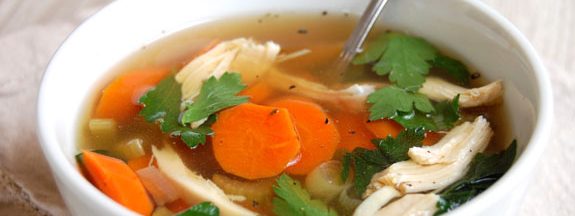By Jason Masters
Environmental Health Director

Stock in the middle with you…
A SUBHEADING
Q: Hey Jason, I love soup in the winter, but have always been afraid of the process. What is a safe way to make homemade soup for the cold winter months?
-Joyce
A: Soup is a wonderful treat on a cold winter day, or if you are like me, at any time throughout the year. Most soups are pretty basic, consisting of stock, meat and/or vegetables, and spices. Some soups introduce cream as a way to thicken and give the soup a silky mouthfeel. But to understand soup, we have to first start with the stock. Stock is just a product of water simmered with meat or bones (or both) for a set time period. Most times, vegetables are added, as well as salt and pepper and any other number of things you might have in the pantry. Simply put, water with meat and bones and those limp pieces of celery you’ve been saving, with a couple pinches of salt thrown in, and simmered for a few hours will produce a product that is far superior to any store bought stock or broth, and will add immense flavor (picture Guy Fieri: “Welcome to flavortown, baby!”) to any soup you make.
So what if you don’t have a half-day to sit around sipping hot tea and daydreaming of what you’re going to do after you retire, while leisurely skimming fat off your bubbling stock? Easy. Throw it all in a pressure cooker, let it sputtle and spurt for an hour, and BOOM, you’re done. Once you have your stock completed, soups, sauces, gravies, etc. are all within your grasp. (We will save sauces and gravies for another issue…)
From a food safety standpoint, cooling your delicious stock is the real issue. The North Carolina Food Code Manual (which is an adaptation of the 2009 FDA food code) dictates that potentially hazardous foods be cooled from 135 degrees F to 70 degrees F within two hours, and from 70 degrees F to 41 degrees F within the following 4 hours, to inhibit the growth of potentially harmful bacteria. The temperature range between 135 degrees F and 41 degrees F is what is commonly known as “The Danger Zone” (cue up your Kenny Loggins, kids…) and is the range that is just perfect for bacteria to thrive. This means exponential growth of bacteria is possible within this temperature range, however, if food is cooled within the parameters mentioned, then food can be safely stored. These are the exact specifications to which restaurants in all counties within the state are held. Some methods to help cool your stock (or any other food for that matter) include: ice baths, ice wands, adding ice to products, or placing products in a cooling unit (but make sure the food is not too hot, or it can warm up other foods in your refrigerator). You don’t need a fancy health inspector thermometer to keep track of your foods internal temperatures either, but spend the $10-15 bucks and grab one of these from Target (http://www.target.com/p/taylor-compact-digital-folding-probe-thermometer/-/A-16965407) or Wal-Mart (https://www.walmart.com/ip/Taylor-TruTemp-Digital-Instant-Read-Thermometer/16541966).
If you think correctly cooling your stock is a pain, try telling a restaurant owner that he has to dump 10 gallons of his Italian Granny’s secret recipe Toscana down the drain…
You can reach the food and lodging division of the environmental health section at 828-287-6317 (Rutherford), 828-894-8004 (Polk), or 828-652-2921 (McDowell), with any questions related to food safety.
Traditional Chicken Stock
-1/2 of chicken carcass
-2-3 ribs of celery broken in half or thirds
-2-3 carrots broken in half or thirds
-whole onion, quartered, with skin on (for color)
-2 garlic cloves, smashed
-generous salt
-generous pepper
-1-2 bay leaves
Take the bones and leftover meat and skin (the skin will add a deep color to the stock and can be omitted if desired) from a roasted chicken or a rotisserie chicken, and break apart. You will only need about a half a chicken carcass to make approx. 8 cups of stock. Freeze the remaining bones and meat for another time. Add bones and meat to a large stock pot, with celery, carrots, onion, garlic cloves, salt, pepper, bay leaf, and whatever other spices you might like. Add 10 cups of water. Bring to a boil, then reduce heat and let simmer for 2-3 hours, tasting and occasionally skimming the fat from the top of the pot if necessary. Will yield about 8 cups of stock. When finished cooking, remove from heat, strain, use immediately for soups or stews, or cool and hold for seven days at 41 degrees or less.
Pressure Cooker Chicken Stock
Add all ingredients from above to pressure cooker, with 10 cups of water, place lid on cooker and seal, on high heat until pressure regulator begins to “speak”. Reduce heat to medium-low, (regulator should speak every few seconds) for about one hour. Remove from heat, strain, use immediately or cool. Will yield about 8 cups of stock.

